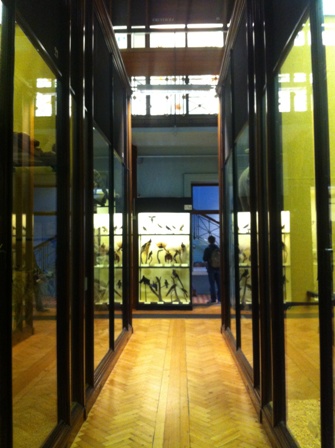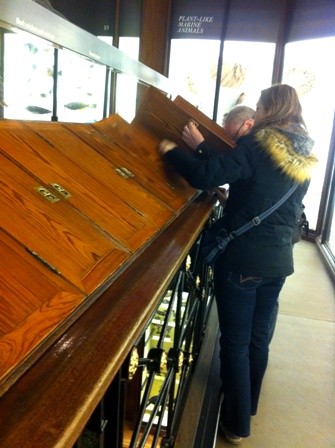Public face: the Bodleian's new Weston Library opens its new doors
New doors and old-school attractions
The Leisure Review’s local library has a new exhibition space with a traditional approach to how its collection is displayed. With these galleries packed with visitors, Jonathan Ives reflects on whether there is still some life in old-school attitudes in our museums.
Public face: the Bodleian's new Weston Library opens its new doors
The opening of a new display space in a library would not ordinarily be considered a radical development but this is Oxford and change does not come easily. The library in question also happens to be the Bodleian, one of the UK’s six legal deposit libraries, a bastion of academic elitism and about as far removed from the popular image of a public library as a building with books in it is likely to be. In addition, the new galleries are situated in the New Bodleian, one of the most obviously unpublic library buildings one could imagine.
Until now.
Officially opened in 1948, the New Bodleian is not a beautiful building. Required to do a dull on a grand scale, Sir Giles Gilbert Scott’s design fulfilled its brief admirably. Inside are 11 levels of book storage stacks and nearly 40 kilometres of shelving holding some 1.5 million volumes and documents. It is by necessity a huge building and, despite its round-edged suggestion of art deco influences, it cannot escape its sheer mass. For all the industry that was taking place inside, it has always been all a bit industrial from the outside.
Its location also adds to its architectural plight. The New Bodleian occupies a corner of one of the city’s most celebrated junctions, a crossroads where visitors gather to photograph buildings by Hawksmoor and Wren, and the nearby rotunda of the Radcliffe Camera (by James Gibbs); with students rushing or ambling to and from the Bodleian’s main reading rooms, this is the focal point of the Oxford academic experience, a photogenic microcosm of university culture.
Of course, Gilbert Scott was not creating a public building and, bar a rather bizarre and entirely decorative front door, no attempt was made to suggest that anyone might be welcome. The readers’ entrance – the actual front door – was tucked away round the corner and would be found by anyone with business inside. The building’s main face, the one shown to Hawksmoor’s Clarendon building and Wren’s Sheldonian theatre, was a largely blank wall with a row small, high windows.
It is here, on this most austere aspect, that the transformation is most obvious. The building’s old brick face has been opened with glass and where once an elevated and inaccessible terrace served as no man’s land to repel visitors, there are now steps and slopes to draw visitors in. Away from the public spaces, the Wilkinson Eyre redesign includes three new reading rooms and extensive research space but it is this new welcome that has reinvented the building. A café and shop, of course, but also two new galleries to house some of the Bodleian’s many treasures and an extended, high-roofed atrium that has created a new public face for one of Oxford’s most insular institutions. And with this new face comes a new name, the Weston Library, in acknowledgement of the £25 million donation to the project from the Garfield Weston Foundation.
For any visitor the display areas are the main attraction. Currently home to an exhibition titled Marks of Genius: Masterpieces from the Collections of the Bodleian Libraries, these two rooms contain some of the most remarkable and valuable printed works imaginable. This being Oxford, there has been a traditional approach to the display, with subdued lighting, glass cases and small information cards to explain a little about the items you can see. There are some hand-held information sheets and a few touch screens in the area between the two main rooms but in the galleries the stage is left to the items on display. This understatement seems to appropriate to the grandeur of these great works and, in the hushed atmosphere it creates, serves as a reminder that we are still in a library.
Given that the Bodleian exists within the context of such a dominant academic tradition, it would be a surprise to find its new public galleries being anything other than understated. However, it is still interesting to reflect on how the transformation of a revered institution has been achieved by what feels like a traditional approach to display. With such focus on interaction and interpretation in the modern museum experience, the Weston Library’s new exhibition feels almost austere; and who could have thought austerity could be so refreshing?
The Leisure Review’s visit to the Weston Library brought to mind another museum that has maintained a traditional approach to how it presents its collections. Like the Weston Library galleries, the Natural History Museum at Tring stands outside the movement for interaction and screen-based interpretation. Unlike the Weston Library, it owes its old-school atmosphere to avoiding rather than embracing transformation.
Although a recent discovery for the Leisure Review, the NHM at Tring is a well-respected and celebrated local outpost of a national institution. Originally known as the Walter Rothschild Zoological Museum after the man who created the collection, the museum came under the auspices of the NHM in 1937 when the collection and the buildings it inhabits were given to the nation by the Rothschild family. The museum still occupies the original building Walter had constructed in 1889 to display the vast array of mounted specimens that he had been collecting since he was seven and, despite both its glass-cased displays and its academic reputation, the NHM at Tring remains a popular visitor attraction.
Walter Rothschild opened the museum to the public in 1892. Then aged 24, he had studied natural sciences at Cambridge and had already developed an interest in zebras. One can imagine that in its current format the museum is little changed since then and it retains an remarkably intimate atmosphere throughout its displays and galleries.
The museum comprises six galleries with some 4,000 specimens on display. There is a shop and a discovery room for school groups but few visitors can have much time for anything beyond the collection. Arranged in taxonomic order as Walter Rothschild preferred, the viewer is left to wander this long-lost world of the animal and insect kingdom. From the alarming scale of fully grown grizzly and polar bears, through apes and marine life to insects, elephants and crocodiles. Along the way one can pore over just a small part of one of the world’s biggest ornithological collections, which totals more than a million specimens. Insects abound, many concealing their beauty and mysteries behind the doors of elegant wooden cabinets. All this in the most atmospheric setting of parquet floors and the endless glass-fronted Victorian display cases.
This is an enthralling museum and in many respects it still sits comfortably with its parent body, the Natural History Museum at South Kensington. Of course, these two museums are so obviously different, not least in their respective scales and roles, that any comparison is specious, but Tring serves as a reminder that the South Kensington museum is at its evocative best in and around its Victorian heart.
As one of the most respected and important museums in the world, the Natural History Museum has developed its relationship with visitors over generations, meeting the various challenges set by the continuing changes to the expectations of visitors and funding bodies. The transformation of the NHM from a Victorian academic institution into a vibrant and engaging venue of discovery while still retaining its research function and status has been a remarkable achievement but the process has perhaps also illustrated how difficult, if not impossible, the pursuit of modernity can be.
The Earth Hall, with its towering escalator to the lively interactive displays, was once at the cutting edge of museum design but now it feels rather dated. Once an exciting centrepiece, there is now an air of galleries lost in space. Elsewhere the slightly out-of-time feel is accentuated by the signage, which now looks drab and at odds with the grandeur of its setting. Modernity is wholly embraced at the Darwin Centre where the Cocoon takes the visitor on a journey of biological discovery through the most avant garde of architectural statements but there is a suspicion that this egg-shaped outbuilding is an example of a museum trying just a bit too hard.
Genuine wonder abounds in the Darwin Centre but it is to be found in the zoology spirit building rather than the Cocoon. The spirit building is home to 27km of shelves housing 22 million specimens suspended and preserved in an endless procession of glass jars. With the help and expertise of the museum’s staff, this is where wonder roams and awe is inspired.
Of course, making a museum accessible and engaging is never just about things in jars and cases. Behind every visitor to every museum is a staff of scholars and administrators, managers and marketers, working hard to make their collection and their building worthy of anyone’s interest. To visit the Natural History Museum at South Kensington at a weekend or during the school holidays is to see children engaged and enthused by science and history in startling numbers. This is clearly a museum getting it right. But it is also interesting to note that its most the most popular of the Natural History Museum’s attractions are those most closely rooted in the museum’s founding traditions: the preservation, study and display of objects of wonder. If this museum, along with the new Bodleian galleries and the NHM at Tring, has retained a traditional feel, it is perhaps a reflection of a justified confidence in the value of their collections and the intelligence of their visitors.
Jonathan Ives is the editor of the Leisure Review.
The Leisure Review, May 2015
© Copyright of all material on this site is retained by The Leisure Review or the individual contributors where stated. Contact The Leisure Review for details.
![]() Download a pdf version of this article for printing
Download a pdf version of this article for printing

Corridors of awe: the NHM at Tring on the case

Under cover: the insect collection reveals its charms